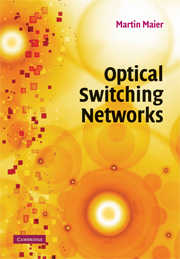Book contents
- Frontmatter
- Contents
- List of illustrations
- List of tables
- Preface
- Acknowledgments
- Part I Introduction
- 1 Historical overview of optical networks
- 2 Optical switching networks
- 3 Building blocks
- 4 Summary
- Part II Optical wide area networks
- Part III Optical metropolitan area networks
- Part IV Optical access and local area networks
- Part V Testbeds
- Bibliography
- Index
4 - Summary
from Part I - Introduction
Published online by Cambridge University Press: 10 May 2010
- Frontmatter
- Contents
- List of illustrations
- List of tables
- Preface
- Acknowledgments
- Part I Introduction
- 1 Historical overview of optical networks
- 2 Optical switching networks
- 3 Building blocks
- 4 Summary
- Part II Optical wide area networks
- Part III Optical metropolitan area networks
- Part IV Optical access and local area networks
- Part V Testbeds
- Bibliography
- Index
Summary
The ultimate goal of the Internet and communications networks in general is to provide access to information when we need it, where we need it, and in whatever format we need it (Mukherjee, 2000). To achieve this goal wireless and optical technologies play a key role in future communications networks. Wireless and optical networks can be thought of as quite complementary. Optical fiber does not go everywhere, but where it does go, it provides a huge amount of available bandwidth. Wireless networks, on the other hand, potentially go almost everywhere and are thus able to support mobility and reachability, but they provide a highly bandwidth-constrained transmission channel, susceptible to a variety of impairments (Ramaswami, 2002). As opposed to the wireless channel, optical fiber exhibits a number of advantageous transmission properties such as low attenuation, large bandwidth, and immunity from electromagnetic interference. Future communications networks will be bimodal, capitalizing on the respective strengths of wireless and optical networks.
Historical review
Optical networks have been long recognized to have many beneficial properties. Among others, optical fiber is well suited to satisfy the growing demand for bandwidth, transparency, reliability, and simplified operation and management (Green, 1996). In this part, we have first reviewed the historical evolution of optical networks from point-to-point links to reconfigurable all-optical WDM networks of arbitrary topology. In our review, we introduced the basic concepts and techniques of optical networking, highlighted key optical network elements (e.g., reconfigurable OADM and OXC), elaborated on the rationale behind the design of all-optical networks, and outlined their similarities to SONET/SDH networks. Furthermore, we identified and explained the most important features of optical networks, namely, transparency, reconfigurability, survivability, scalability, and modularity.
- Type
- Chapter
- Information
- Optical Switching Networks , pp. 42 - 50Publisher: Cambridge University PressPrint publication year: 2008



